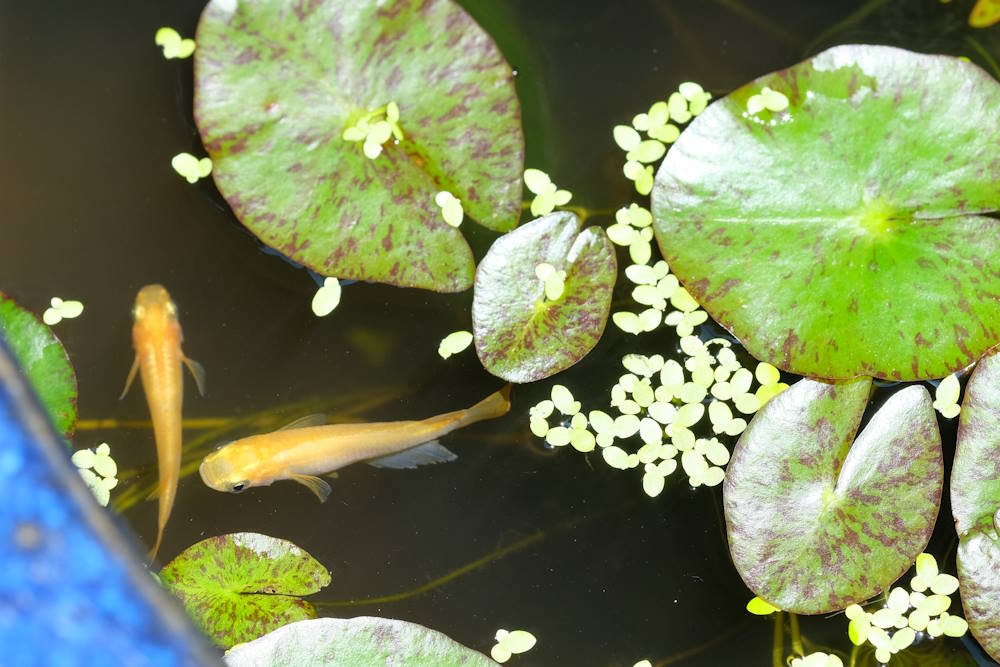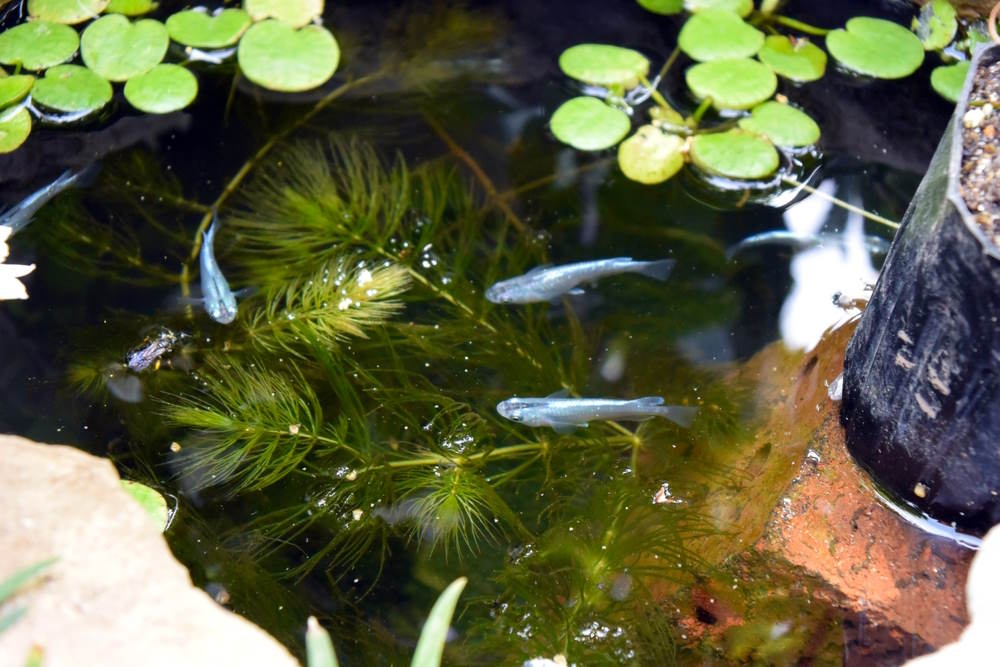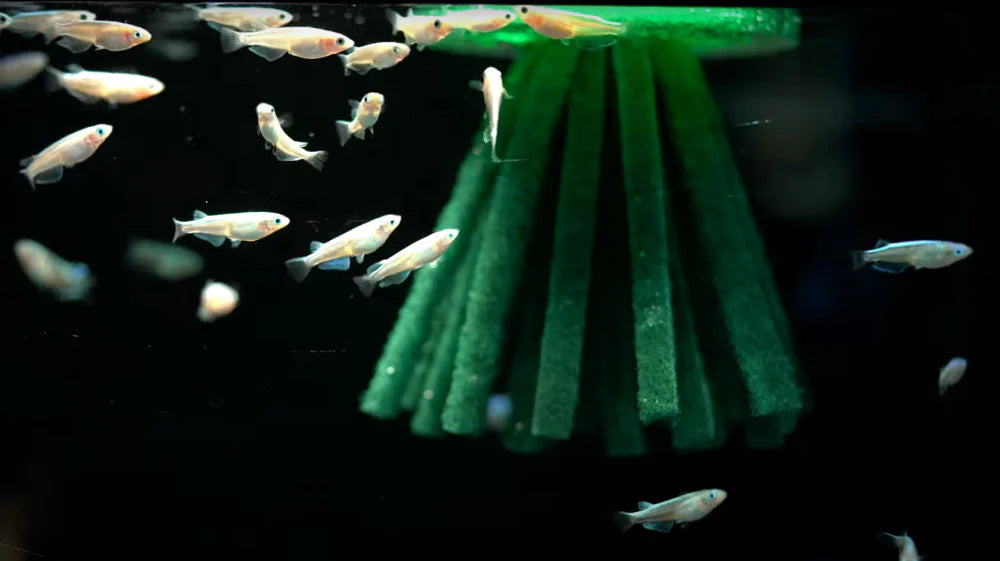Care Guide for Medaka Rice Fish — Best Cool Water Fish for Beginners
Have you ever kept Medaka rice fish? Because of their ability to reproduce very quickly at a young age and tolerance for a wide temperature range, they are commonly used in research areas such as biology, genetics, and toxicology. In 1994, they even became the first vertebrate to successfully mate and lay eggs that hatched while in space. Medaka rice fish have been raised as pet fish in Japan for hundreds of years but recently gained more popularity in the worldwide aquarium trade. Learn how to care for this amazing fish in your home or outdoor mini pond.

Platinum white Medaka
What are Medaka Rice Fish?
Oryzias latipes is commonly known as the Medaka or Japanese ricefish. Their genus comes from the Greek word for “rice” because they are frequently found in rice paddies. This torpedo-shaped fish grows up to 1.5 inches (4 cm) and often has a blue or silvery eye. There are hundreds of different colors and varieties that have been line bred over the years, such as gold, pearl galaxy, Yokihi orange, Orochi black, blue, Tancho red cap, Miyuki blue, and platinum white. Usually, they sell for a few dollars per fish, but for very rare and desirable strains, a clutch of eggs may cost over $100.
They are incredibly hardy, peaceful, and energetic, which makes them one of the most beginner-friendly fish to get for your first aquarium or outdoor pond. Hobbyists report that ricefish are quite friendly and will come up to the front of the tank to beg for food. In the wild, they live for only 1–2 years, but their lifespan can reach up to 5 years in captivity.

Medaka living in outdoor mini pond
How to Set Up an Aquarium for Rice Fish
Japanese rice fish can be found all over Asia in areas such as Japan, Korea, China, and Vietnam. As per their name, they prefer rice paddy fields, marshes, and other slow-moving waterways. Surprisingly, they can also live in both freshwater and strongly brackish waters and will often travel between streams and the ocean for non-breeding purposes. They have a huge tolerance for temperatures between 60–75°F (16–24°C), pH levels of 6.5–8.5, and moderately soft to very hard GH. While they can live in even hotter (and colder) temperatures, we prefer keeping them in unheated fish tanks and outdoor ponds since warmer water can increase their metabolism and shorten their longevity.
Medaka can live in a 10-gallon fish tank (or mini pond) with a sponge filter for slower current. They may jump out of the water, so consider using an aquarium lid or lots of floating plants to cover the surface and help keep the water clean. If you find that the males are excessively chasing each other, try adding more plants to block line of sight, increasing the number of females, or removing some males.

Medaka rice fish living in planted community tank
What fish can live with medakas? Keep them in a school of six or more in a species-only breeding tank or a community setup. They get along with all kinds of similar-sized, peaceful tank mates that also enjoy cooler temperatures — like white cloud mountain minnows, hillstream loaches, shiners, amano shrimp, and snails. They can also live with adult Neocaridina cherry shrimp, but the Medaka may eat baby shrimp and the adult shrimp may eat rice fish eggs.
What Do Japanese Rice Fish Eat?
Rice fish tend to prefer eating tiny foods that float on the surface of the water, which is perfect when you want to view them in your outdoor pond. They are not picky eaters, but remember to feed them a varied diet of many different fish foods so that they will not suffer from any nutrient deficiencies. Medaka love to consume crushed flakes, freeze-dried tubifex worms, Easy Fry and Small Fish Food, and any live mosquito larvae that naturally hatch in the pond.

Miyuki blue ricefish eating from the surface
How to Breed Medaka Rice Fish
To breed Japanese ricefish, you need at least one male and one female. Females are generally bigger and plumper with a shorter anal fin that is triangle-shaped (e.g., wider near the abdomen and narrower near the tail). Males, on the other hand, have a slender body with a wider anal fin shaped like a parallelogram. If the Medakas are too young or you aren’t able to sex them, get a group of six or more to increase your chances of getting both genders.
Rice fish are very easy to breed, as long as you feed them plenty of food and the temperature isn’t too cold. If you want to colony breed them so that the fry grow up in the same tank as the adults, set up a species-only, 10-gallon tank or pond with slow flow and lots of floating plants with long roots (e.g., dwarf water lettuce and water hyacinth). If you want to increase your yield, consider making a DIY ricefish spawning mop that can be easily removed from the breeding tank.

DIY spawning mop for rice fish
You can tell that the fish are in breeding mode if the males are chasing each other and the females are carrying a cluster of sticky eggs in front of their anal fin. They can lay eggs on a daily basis and will deposit them on plants, spawning mops, and even sponge filters. To avoid predation, these eggs can be moved to a separate container either by taking out the entire spawning mop or picking them up individually by hand. Medakas produce fairly large, 1.5 mm eggs that are clear in color and will gradually darken as the fry develops. (If you find any solid white eggs, they are no longer viable and should be removed to prevent fungal growth from spreading to the rest of the brood.)
At 77°F (or 25°C), the eggs can start hatching in a little under a week but will take longer if the temperature is cooler. Once the newborns are free swimming, feed them newly hatched baby brine shrimp, powdered fry food, vinegar eels, and paramecium. To make sure the babies can reach their food, you can keep them in a small container for a while, as long as you do frequent water changes. Eventually, they should graduate to a bigger rearing tank with lots of plants, mulm, and microfauna to snack on. Within 3–4 months, they should be large enough to sell for profit at your local fish store or aquarium society.

Female Medaka holding eggs
We hope you’ll try your hand at keeping and breeding this wonderfully enjoyable species. While we do not ship live fish at Aquarium Co-Op, you can check out the latest stock of Medaka rice fish sold by our preferred online retailers.




